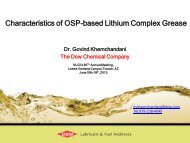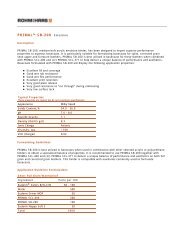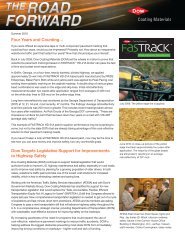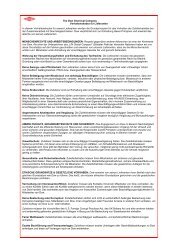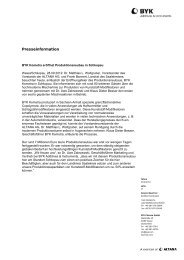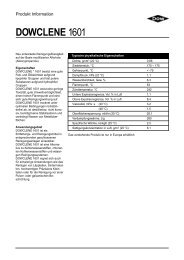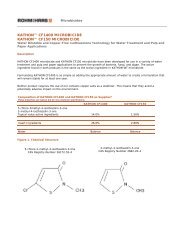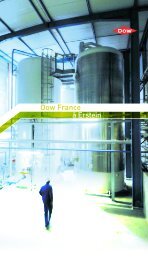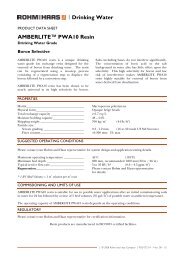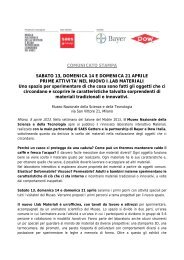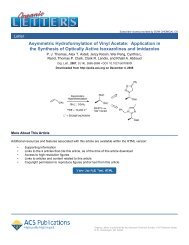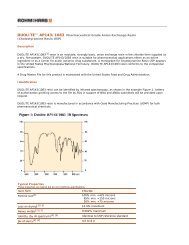DOWTHERM SR-1 and DOWFROST HD Heat Transfer Fluids In ...
DOWTHERM SR-1 and DOWFROST HD Heat Transfer Fluids In ...
DOWTHERM SR-1 and DOWFROST HD Heat Transfer Fluids In ...
You also want an ePaper? Increase the reach of your titles
YUMPU automatically turns print PDFs into web optimized ePapers that Google loves.
Automatic make-up water<br />
systems<br />
Automatic make-up water systems<br />
should be avoided in order to<br />
prevent undetected dilution or<br />
loss of glycol <strong>and</strong> consequent loss<br />
of freeze <strong>and</strong> corrosion protection.<br />
A preferred system would be a low<br />
level alarm on the expansion tank<br />
to alert maintenance personnel in<br />
case of a low fluid level condition<br />
<strong>and</strong> prompt corrective action.<br />
Expansion factor<br />
Like any fluids, solutions of<br />
<strong>DOWTHERM</strong> <strong>and</strong> <strong>DOWFROST</strong><br />
fluids exp<strong>and</strong> as temperature<br />
increases. Therefore, expansion<br />
tanks must be sized appropriately.<br />
To determine the volume of<br />
expansion, use the following<br />
formula:<br />
ρ(T LOW )-ρ(T HIGH ) Expansion<br />
_______________ x Volume =Volume<br />
4<br />
ρ(T HIGH )<br />
Where,<br />
ρ(T LOW ) = the density at the<br />
lowest anticipated<br />
temperature.<br />
ρ(T HIGH ) = the density at the<br />
highest anticipated<br />
temperature.<br />
Density data for <strong>DOWTHERM</strong><br />
<strong>SR</strong>-1 <strong>and</strong> <strong>DOWFROST</strong> <strong>HD</strong> fluids<br />
are given in Tables 4 <strong>and</strong> 6<br />
respectively.<br />
One method for sizing an expansion<br />
tank is to use the determined<br />
expansion volume to calculate the<br />
total size of the tank. A typical<br />
tank size would allow the fluid to<br />
fluctuate between the levels<br />
associated with 15% <strong>and</strong> 80% full.<br />
The tank size is calculated from:<br />
Expansion Volume/0.65 = Tank Size<br />
When using this method, ensure<br />
that the minimum amount of fluid<br />
in the tank will provide the NPSH<br />
(net positive suction head) of the<br />
pump if the tank is a portion of<br />
the source of head.<br />
It should also be noted that in<br />
some ice storage systems, such as<br />
the ice encapsulated systems,<br />
when ice is made, the plastic<br />
containers exp<strong>and</strong>. This expansion<br />
will cause the level of the<br />
glycol water solution to rise <strong>and</strong><br />
should also be considered when<br />
sizing the expansion tank for this<br />
type of system. Manufacturers of<br />
this type of ice storage system can<br />
assist you with this calculation.<br />
System cleaning<br />
When preparing a system for the<br />
addition of <strong>DOWTHERM</strong> <strong>SR</strong>-1<br />
or <strong>DOWFROST</strong> <strong>HD</strong> heat transfer<br />
fluid, certain procedures should be<br />
followed. The procedure will vary<br />
depending on whether you are<br />
retrofitting an existing system or<br />
filling a new system for the first<br />
time.<br />
New systems<br />
New systems are typically coated<br />
with oil, grease or a protective film<br />
during fabrication, storage or<br />
construction. Dirt, solder flux, <strong>and</strong><br />
welding <strong>and</strong> pipe scale can also<br />
cause problems. Therefore, thorough<br />
cleaning of new systems is<br />
recommended. A solution of 1-2<br />
percent trisodium phosphate can<br />
be used with water for flushing the<br />
system. System volume can be<br />
calculated during this stage by<br />
metering-in the initial fill of the<br />
system or by chemical analysis of<br />
cleaning chemical after known<br />
quantities are introduced into the<br />
system.<br />
Existing systems<br />
<strong>In</strong> existing systems, all lines <strong>and</strong><br />
materials should be cleaned <strong>and</strong><br />
flushed thoroughly before charging<br />
the system with <strong>DOWTHERM</strong><br />
<strong>SR</strong>-1 or <strong>DOWFROST</strong> <strong>HD</strong> fluid.<br />
This is especially important if fluid<br />
previously in the system is<br />
incompatible with the new<br />
inhibited glycol fluid. A Dow<br />
technical service representative<br />
can help you determine the<br />
compatibility of other fluids with<br />
<strong>DOWTHERM</strong> <strong>and</strong> <strong>DOWFROST</strong><br />
fluids.<br />
If fluid containing silicates (such<br />
as automotive antifreeze) was<br />
previously used, it may be necessary<br />
to clean silicate residues from<br />
the system.<br />
It is also important to remove all<br />
rust, scale <strong>and</strong> sediment in the<br />
system. Traces of chloride should<br />
be removed – whether from old<br />
fluid or residue from acid cleaner –<br />
because chlorides can contribute<br />
to corrosion. For large systems or<br />
systems where corrosion is already<br />
evident, consult a professional<br />
cleaning organization.<br />
For heavily fouled or corroded<br />
systems, an optimum cleaning<br />
procedure includes the use of an<br />
inhibited acid followed by neutralization<br />
<strong>and</strong> phosphatization. This<br />
procedure is quite involved <strong>and</strong><br />
should be done by a company<br />
experienced in industrial cleaning.<br />
If chemical cleaning is used, it is<br />
important that all traces of the<br />
cleaning agent be removed <strong>and</strong><br />
the system thoroughly flushed<br />
with water.



